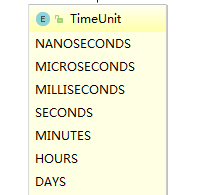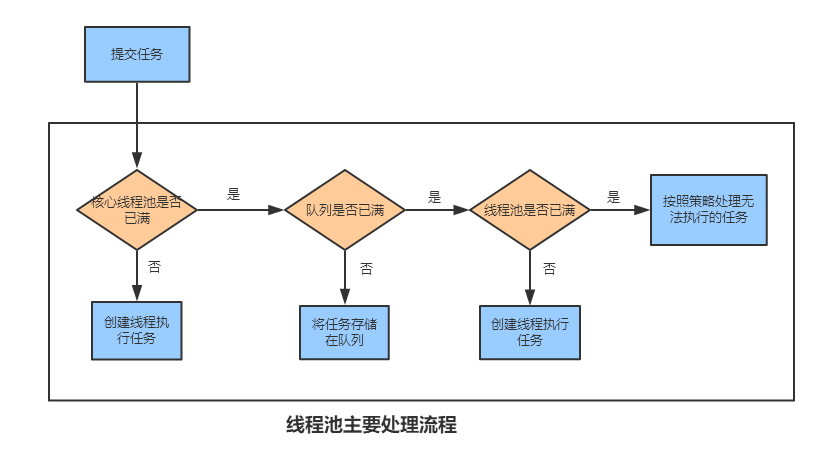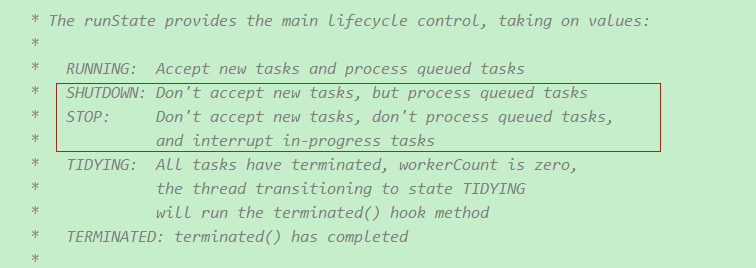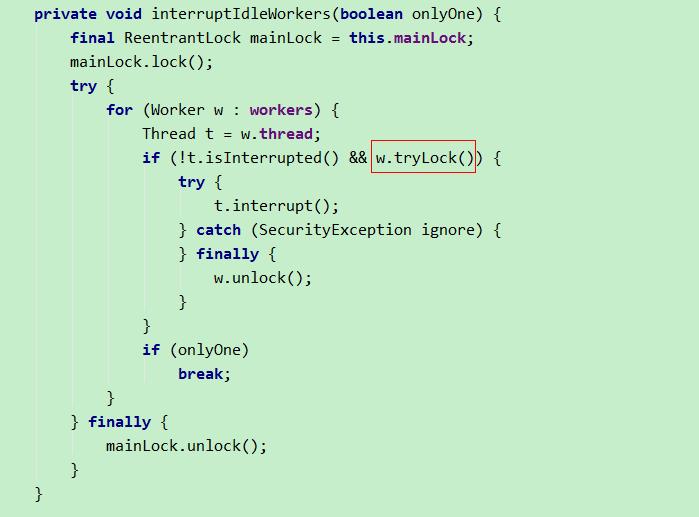java线程池的使用学习
1. 线程池的创建
线程池的创建使用ThreadPoolExecutor类,有利于编码时更好的明确线程池运行规则。

//构造函数
/**
* Creates a new {@code ThreadPoolExecutor} with the given initial
* parameters.
*
* @param corePoolSize the number of threads to keep in the pool, even
* if they are idle, unless {@code allowCoreThreadTimeOut} is set
* @param maximumPoolSize the maximum number of threads to allow in the
* pool
* @param keepAliveTime when the number of threads is greater than
* the core, this is the maximum time that excess idle threads
* will wait for new tasks before terminating.
* @param unit the time unit for the {@code keepAliveTime} argument
* @param workQueue the queue to use for holding tasks before they are
* executed. This queue will hold only the {@code Runnable}
* tasks submitted by the {@code execute} method.
* @param threadFactory the factory to use when the executor
* creates a new thread
* @param handler the handler to use when execution is blocked
* because the thread bounds and queue capacities are reached
* @throws IllegalArgumentException if one of the following holds:<br>
* {@code corePoolSize < 0}<br>
* {@code keepAliveTime < 0}<br>
* {@code maximumPoolSize <= 0}<br>
* {@code maximumPoolSize < corePoolSize}
* @throws NullPointerException if {@code workQueue}
* or {@code threadFactory} or {@code handler} is null
*/
public ThreadPoolExecutor(int corePoolSize,
int maximumPoolSize,
long keepAliveTime,
TimeUnit unit,
BlockingQueue<Runnable> workQueue,
ThreadFactory threadFactory,
RejectedExecutionHandler handler) {
if (corePoolSize < 0 ||
maximumPoolSize <= 0 ||
maximumPoolSize < corePoolSize ||
keepAliveTime < 0)
throw new IllegalArgumentException();
if (workQueue == null || threadFactory == null || handler == null)
throw new NullPointerException();
this.corePoolSize = corePoolSize;
this.maximumPoolSize = maximumPoolSize;
this.workQueue = workQueue;
this.keepAliveTime = unit.toNanos(keepAliveTime);
this.threadFactory = threadFactory;
this.handler = handler;
}
参数含义
(1) 核心线程数corePoolSize: 保持在池中的线程数
(2) 最大线程数maximumPoolSize
(3) 保活时间keepAliveTime: 线程数大于corePoolSize,闲置线程最大空闲时间
(4) 时间单位unit

(5) 阻塞队列workQueue
java.util.concurrent.BlockingQueue主要实现类有:
- ArrayBlockingQueue: 数组结构有界阻塞队列,FIFO排序。其构造函数必须设置队列长度。
- LinkedBlockingQueue:链表结构有界阻塞队列,FIFO排序。队列默认最大长度为Integer.MAX_VALUE,故可能会堆积大量请求,导致OOM。

- PriorityBlockingQueue:支持优先级排序的无界阻塞队列。默认自然顺序排列,可以通过比较器comparator指定排序规则。
- DelayQueue:支持延时获取元素的无界阻塞队列。队列使用PriorityQueue实现。
(6) 线程创建接口threadFactory
- 默认使用Executors.defaultThreadFactory()。
- 可以自定义ThreadFactory实现或使用第三方实现,方便指定有意义的线程名称。
import com.google.common.util.concurrent.ThreadFactoryBuilder;
...
ThreadFactory namedThreadFactory = new ThreadFactoryBuilder().setNameFormat("my-pool-%d").build();
public class MyThreadFactory implements ThreadFactory {
private final AtomicInteger threadNumber = new AtomicInteger(1);
private final String namePrefix;
MyThreadFactory(String namePrefix) {
this.namePrefix = namePrefix+"-";
}
@Override
public Thread newThread(Runnable r) {
Thread t = new Thread( r,namePrefix + threadNumber.getAndIncrement());
if (t.isDaemon()) {
t.setDaemon(true);
}
if (t.getPriority() != Thread.NORM_PRIORITY) {
t.setPriority(Thread.NORM_PRIORITY);
}
return t;
}
}
(7) 饱和策略handler
- ThreadPoolExecutor.AbortPolicy():终止策略(默认) , 抛出java.util.concurrent.RejectedExecutionException异常。
- ThreadPoolExecutor.CallerRunsPolicy(): 重试添加当前的任务,他会自动重复调用execute()方法。
- ThreadPoolExecutor.DiscardOldestPolicy(): 抛弃下一个即将被执行的任务,然后尝试重新提交新的任务。最好不和优先级队列一起使用,因为它会抛弃优先级最高的任务。
- ThreadPoolExecutor.DiscardPolicy(): 抛弃策略, 抛弃当前任务。
2. 线程池的运行规则
execute添加任务到线程池:
一个任务通过execute(Runnable)方法被添加到线程池。任务是一个 Runnable类型的对象,任务的执行方法就是 Runnable类型对象的run()方法。
线程池运行规则:
当一个任务通过execute(Runnable)方法添加到线程池时:

如果此时线程池中的数量小于corePoolSize,即使线程池中的线程都处于空闲状态,也要创建新的线程来处理被添加的任务。
如果此时线程池中的数量等于 corePoolSize,但是缓冲队列 workQueue未满,那么任务被放入缓冲队列。
如果此时线程池中的数量大于corePoolSize,缓冲队列workQueue满,并且线程池中的数量小于maximumPoolSize,建新的线程来处理被添加的任务。
如果此时线程池中的数量大于corePoolSize,缓冲队列workQueue满,并且线程池中的数量等于maximumPoolSize,那么通过 handler所指定的策略来处理此任务。
也就是:处理任务的优先级为:
核心线程corePoolSize - > 任务队列workQueue - > 最大线程maximumPoolSize
如果三者都满了,使用handler策略处理该任务。
- 当线程池中的线程数量大于 corePoolSize时,如果某线程空闲时间超过keepAliveTime,线程将被终止。这样,线程池可以动态的调整池中的线程数。
// execute方法源码实现(jdk1.8)
public void execute(Runnable command) {
if (command == null)
throw new NullPointerException();
/*
* Proceed in 3 steps:
*
* 1. If fewer than corePoolSize threads are running, try to
* start a new thread with the given command as its first
* task. The call to addWorker atomically checks runState and
* workerCount, and so prevents false alarms that would add
* threads when it shouldn't, by returning false.
*
* 2. If a task can be successfully queued, then we still need
* to double-check whether we should have added a thread
* (because existing ones died since last checking) or that
* the pool shut down since entry into this method. So we
* recheck state and if necessary roll back the enqueuing if
* stopped, or start a new thread if there are none.
*
* 3. If we cannot queue task, then we try to add a new
* thread. If it fails, we know we are shut down or saturated
* and so reject the task.
*/
int c = ctl.get();
if (workerCountOf(c) < corePoolSize) {
if (addWorker(command, true))
return;
c = ctl.get();
}
if (isRunning(c) && workQueue.offer(command)) {
int recheck = ctl.get();
if (! isRunning(recheck) && remove(command))
reject(command);
else if (workerCountOf(recheck) == 0)
addWorker(null, false);
}
else if (!addWorker(command, false))
reject(command);
}
3. 线程池的关闭
通过调用线程池的shutdown或shutdownNow方法来关闭线程池。
- shutdown:将线程池的状态设置成SHUTDOWN状态,然后interrupt空闲线程。
- shutdownNow:线程池的状态设置成STOP,然后尝试interrupt所有线程,包括正在运行的。
关于线程池状态,源码中的注释比较清晰:

再看一下源代码:
// 在关闭中,之前提交的任务会被执行(包含正在执行的,在阻塞队列中的),但新任务会被拒绝。
public void shutdown() {
final ReentrantLock mainLock = this.mainLock;
mainLock.lock();
try {
checkShutdownAccess();
// 状态设置为shutdown
advanceRunState(SHUTDOWN);
// interrupt空闲线程
interruptIdleWorkers();
onShutdown(); // hook for ScheduledThreadPoolExecutor
} finally {
mainLock.unlock();
}
// 尝试终止线程池
tryTerminate();
}
其中,interruptIdleWorkers()方法往下调用了interruptIdleWorkers(), 这里w.tryLock()比较关键。
中断之前需要先tryLock()获取worker锁,正在运行的worker tryLock()失败(runWorker()方法会先对worker上锁),故正在运行的worker不能中断。

// 尝试停止所有正在执行的任务,停止对等待任务的处理,并返回正在等待被执行的任务列表
public List<Runnable> shutdownNow() {
List<Runnable> tasks;
final ReentrantLock mainLock = this.mainLock;
mainLock.lock();
try {
checkShutdownAccess();
// 状态设置为STOP
advanceRunState(STOP);
// 停止所有线程 interruptWorkers逻辑简单些,循环对所有worker调用interruptIfStarted().(interrupt所有线程)
interruptWorkers();
tasks = drainQueue();
} finally {
mainLock.unlock();
}
tryTerminate();
return tasks;
}
4. 线程池的使用场合
(1)单个任务处理的时间比较短;
(2)需要处理的任务数量大;
5. 线程池大小的设置
可根据计算任务类型估算线程池设置大小:
cpu密集型:可采用Runtime.avaliableProcesses()+1个线程;
IO密集型:由于阻塞操作多,可使用更多的线程,如2倍cpu核数。
6 实现举例
场景: ftp服务器收到文件后,触发相关搬移/处理操作。
public class FtpEventHandler extends DefaultFtplet {
@Override
public FtpletResult onUploadEnd(FtpSession session, FtpRequest request)
throws FtpException, IOException {
// 获取文件名
String fileName = request.getArgument();
Integer index = fileName.lastIndexOf("/");
String realFileName = fileName.substring(index + 1);
index = realFileName.lastIndexOf("\\");
realFileName = realFileName.substring(index + 1);
// **处理文件**
ThreadPoolExecutor threadPool = new ThreadPoolExecutor(10, 50, 10,
TimeUnit.SECONDS, new ArrayBlockingQueue<Runnable>(3));
threadPool.execute(new fileSenderThread(realFileName));
return FtpletResult.DEFAULT;
}
}
Spring也提供了ThreadPoolTaskExecutor
<!--spring.xml配置示例-->
<bean id="gkTaskExecutor" class="org.springframework.scheduling.concurrent.ThreadPoolTaskExecutor">
<property name="allowCoreThreadTimeOut" value="true"/>
<property name="corePoolSize" value="10"/>
<property name="maxPoolSize" value="50"/>
<property name="queueCapacity" value="3"/>
<property name="keepAliveSeconds" value="10"/>
<property name="rejectedExecutionHandler"
value="#{new java.util.concurrent.ThreadPoolExecutor$CallerRunsPolicy()}"/>
<property name="threadNamePrefix" value="gkTaskExecutor"/>
</bean>
//java代码中注入bean
@Autowired
@Qualifier("gkTaskExecutor")
private ThreadPoolTaskExecutor gkTaskExecutor;
end.
java线程池的使用学习的更多相关文章
- 【Java线程池快速学习教程】
1. Java线程池 线程池:顾名思义,用一个池子装载多个线程,使用池子去管理多个线程. 问题来源:应用大量通过new Thread()方法创建执行时间短的线程,较大的消耗系统资源并且系统的响应速度变 ...
- Java线程池学习
Java线程池学习 Executor框架简介 在Java 5之后,并发编程引入了一堆新的启动.调度和管理线程的API.Executor框架便是Java 5中引入的,其内部使用了线程池机制,它在java ...
- Java线程池快速学习教程
1. Java线程池 线程池:顾名思义,用一个池子装载多个线程,使用池子去管理多个线程. 问题来源:应用大量通过new Thread()方法创建执行时间短的线程,较大的消耗系统资源并且系统的响应速度变 ...
- Java线程池学习心得
一.普通线程和线程池的对比 new Thread的弊端如下: a. 每次new Thread新建对象性能差.b. 线程缺乏统一管理,可能无限制新建线程,相互之间竞争,及可能占用过多系统资源导致死机或o ...
- (转载)JAVA线程池管理
平时的开发中线程是个少不了的东西,比如tomcat里的servlet就是线程,没有线程我们如何提供多用户访问呢?不过很多刚开始接触线程的开发攻城师却在这个上面吃了不少苦头.怎么做一套简便的线程开发模式 ...
- 四种Java线程池用法解析
本文为大家分析四种Java线程池用法,供大家参考,具体内容如下 http://www.jb51.net/article/81843.htm 1.new Thread的弊端 执行一个异步任务你还只是如下 ...
- Java线程池的原理及几类线程池的介绍
刚刚研究了一下线程池,如果有不足之处,请大家不吝赐教,大家共同学习.共同交流. 在什么情况下使用线程池? 单个任务处理的时间比较短 将需处理的任务的数量大 使用线程池的好处: 减少在创建和销毁线程上所 ...
- Java线程池带图详解
线程池作为Java中一个重要的知识点,看了很多文章,在此以Java自带的线程池为例,记录分析一下.本文参考了Java并发编程:线程池的使用.Java线程池---addWorker方法解析.线程池.Th ...
- Java线程池详解
一.线程池初探 所谓线程池,就是将多个线程放在一个池子里面(所谓池化技术),然后需要线程的时候不是创建一个线程,而是从线程池里面获取一个可用的线程,然后执行我们的任务.线程池的关键在于它为我们管理了多 ...
随机推荐
- STM32---初学者用库函数好还是直接对寄存器操作比较好
引用:http://blog.csdn.net/u010349006/article/details/416 首先,两个都是C语言.从51过渡过来的话,就先说寄存器操作.每个MCU都有自己的寄存器,5 ...
- SQL一些记录
1,2字段约束create unique index [索引名] on 软件信息表(S_SName,S_Edition)
- 使用Echarts的步骤
Echarts官网地址:https://echarts.baidu.com/index.html 步骤如下: 1.获取Echarts (1)可以在Echarts官网去下载,选择需要的版本下载,根据开发 ...
- artTemplate(mark)
一个渲染性能出众模板引擎,无论在 NodeJS 还是在浏览器中都可以运行. 特性 拥有接近 JavaScript 渲染极限的的性能 调试友好:语法.运行时错误日志精确到模板所在行:支持在模板文件上打断 ...
- 新建Application 报错android.app.Application cannot be cast
我在开发APP的时候重新使用了一个类,继承了android.app.Application.但是在运行的时候提示java.lang.ClassCastException: android.app.Ap ...
- cacti ERROR: FILE NOT FOUND
Cacti 版本: 0.8a 在安装好 cacti之后,进入Settings -> Paths, 而且里面的路径在系统中都存在的,在这里显示ERROR: FILE NOT FOUND 参考1的博 ...
- iptbales无法正常重启
新主机iptables无法启动关闭和重启 一般是由于没有配文件导致 解决办法 直接touch /etc/sysconfig/iptables 然后就可以正常启动. 备注:一般存在于centos6系列中
- re.groups取出来的空元祖??
源自学习笔记: day23_1_re_ groups方法取出来的字符是空的元组??为啥? ''' # ------------------------------------------------- ...
- ps快速将白底图片变为透明图片
方法一: 如果图层有锁图标,则要点击它,然它消失.然后选中魔棒工具,然后点击图片上要透明的区域,按下backspace键即可. 方法二: 转载自:https://blog.csdn.net/sunyi ...
- floyd类型题UVa-10099-The Tourist Guide +Frogger POJ - 2253
The Tourist Guide Mr. G. works as a tourist guide. His current assignment is to take some tourists f ...
